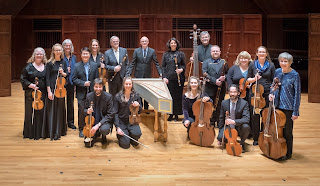Indianapolis Baroque Orchestra opens new season with concerto grosso survey
 |
| The Indianapolis Baroque Orchestra gathers for a group portrait. |
Early displays of acclaimed virtuosity tended to come from violinist-composers, so it's no surprise several of them were responsible for the emergence of the concerto as an essential part of the repertoire. It all began with the idea of a small group of soloists contrasted with an accompanying orchestra in the form, developed in Rome in the late 17th and early 18th centuries, known as the concerto grosso. A well-managed survey of this kind of work opened the Indianapolis Baroque Orchestra season Sunday afternoon at the Indiana History Center.
Barthold Kuijken, the ensemble's artistic director, conducted four works, starting with the foundational concerto-grosso contribution of Arcangelo Corelli. The program progressed through two highly contrasting examples of the form by Francesco Geminiani and Piero Antonio Locatelli before ending on the lofty plain of the High Baroque with George Frideric Handel (the familiar Anglicization of the German-born Georg Friedrich Händel's name).
"Ticket to Ride" was the Beatles-inspired title of the concert, reflecting 18th-century sojourns and settlement in
 |
| Barthold Kuijken, conductor and artistic director |
Before settling in England, and ironically patronized by fellow Saxon monarchs there, Handel had already established a reputation in Italy, where the sobriquet "il Sassone" was applied to him. That influence led to his later basing much of his fame on Italian opera, which he composed with passionate commitment for a number of years after he emigrated for good to England.
Concerto Grosso in G major, op. 6, no. 1, emerged near the end of its composer's production of operatic hits and the start of his successful turn toward the oratorio. The whole set of twelve displays Handel's mastery of the form, and the IBO's performance of the G major thus put a fitting cap on the survey. Each of the five movements bears Handel hallmarks: stately themes in dotted rhythms, the rounded, jog-trot pace familiar from the arias, soloist independence in slow-movement lyrical material, smooth fugal writing, and (for the finale) a triple-meter romp with upward-sweeping lines. Handel had mastered the public manner that career demands in his adopted country embedded in him.
Corelli, who established the genre in a fashion that justifies its comparison to a cult, was attractively displayed in his op. 6, no. 1 (D major). The concertino group, headed by Alison Nyquist, often presented phrases that were then imitated by the ensemble, and Kuijken accomplished the contrast without making the seams conspicuous. Nyquist was given extensive focus in the gigue-like finale, in which she dazzled.
"La Follia" was a tune, or closer to the framework of a tune, that became so much "a thing" in the 18th century that it might be compared to the endless variations on Gershwin's "I Got Rhythm" in the 20th century. Geminiani's Concerto Grosso in D minor makes exhaustive use of it, and the performance featured crisply rendered accents indicating its dance origin as well as spectacular variations for solo violin and cello.
Contrast of another type came into play after intermission with Locatelli's "Il Pianto d'Arianna," a sprawling approximation of the mythological heroine Ariadne's despair at her abandonment on the island of Naxos by her lover Theseus. A modern summary of her complaint might run something like: I put you through graduate school in heroism with that Minotaur, and now you do this to me!
The work features lots of variety in sketching Ariadne's angry and despairing moods. Phrases separated by suspenseful pauses (don't we all go through dead zones in the course of processing deep disappointment?) were unanimously handled. The descriptive vivacity of this performance was unfailing. Clearly, the heroine had been left holding her ticket to ride as her intended transportation sailed away. The Indianapolis public has another opportunity to wave a mournful goodbye with Ariadne at the University of Indianapolis tonight, when the program is repeated.



Comments
Post a Comment